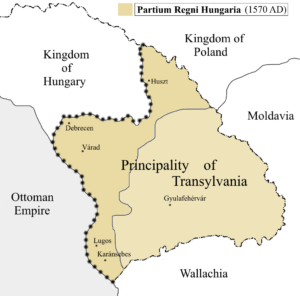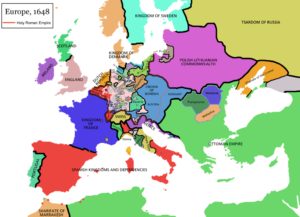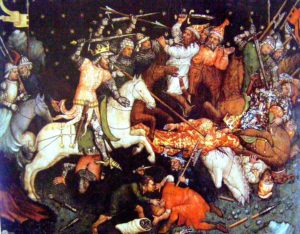Misconceptions, generalizations
There are basically two main groups of misconceptions. From time to time we bump into articles or films that were created out of sheer ignorance or dull superficial generalizations. These tabloid-style pieces of information about Hungarians and Turks are only created to attract attention and sell advertisements. They are rather annoying than ill-purposed. We have to add the stereotypical things that are taught in schools, like “the Kingdom of Hungary disappeared after 1526”. However, there are quite a few posts and films out there which serve as religious, ethnic, or political propaganda. Let us list the ten most common misconceptions:
1. It was the mighty Habsburgs alone who stopped the Ottoman expansion.

A half-truth is a full lie. The Habsburgs would not have been able to stop the Ottomans without the military help of the Hungarians and the Croatians. In fact, they just made the situation worse when they failed to support Hungary or attacked it from the west, like in the age of King Matthias Corvinus. Later, the Habsburgs managed to get the Hungarian crown but they were not the best masters of their Hungarian subjects and could not fulfill their promise of driving out the Turks for 150 years. Yes, they and other West European countries finally “liberated” Hungary but not without the locals’ sabers. As for the Habsburgs, let us read an article about their connection with the Zrínyi / Zrinski family, and you will find out the truth about them:
https://www.hungarianottomanwars.com/essays/the-zrinyi-family-and-the-habsburgs/
2. It was the staunch Hungarians alone who stopped the Turks.

It is not true, either. Yet, we have to underline the fact that the bulk of the fight was done by the inhabitants of the Carpathian Basin, mainly by the Hungarians. On the other hand, we have several dividing figures, like Prince Bocskai István who is sometimes said to have helped the Turks. Balancing the power between the two super empires was not very easy. Read my article about his role:
https://www.hungarianottomanwars.com/essays/prince-bocskai-istvan/
At the same time, some brave Austrian soldiers excelled themselves in the Ottoman wars, fighting against the common enemy. One of them was General Lazarus von Schwendi (1522-1583), the Chief Captain of Kassa (Kosice, Kaschau), the General of Emperor Maximilian II who wrote the following: “…if we lost Hungary, all the weight of our defense and struggle for freedom would fall on our German peasants.” You can read more about his life here:
https://www.hungarianottomanwars.com/essays/general-schwendi-in-royal-hungary-a-german-hero/

3. The Ottoman rule brought about peace and prosperity in the Balkan and in Hungary. Religious tolerance prevailed and there was no bloody national contest in the Empire.

This statement is simply not true. The Ottomans left behind a mess on the Balkan which is still an ethnic nightmare. On the other hand, Hungary was ruined and robbed by the conquerors, including Transylvania. How many of us were slaughtered or enslaved? What happened to our built heritage? Read why we do not have so many nice Gothic and Renaissance buildings in Hungary:
https://www.hungarianottomanwars.com/essays/why-is-the-hungarian-renaissance-not-so-well-known/
4. Törcsvár (Bran) castle was the nest of Count Dracula in Transylvania.

Of course not. It is a fake tourist business to attract visitors. German Saxons, Hungarians, and even Romanians can be proud of Törcsvár castle, for different historical reasons but not because of a made-up horror figure. Instead, read the history of Törcsvár here:
https://www.hungarianottomanwars.com/transylvania/torcsvar/
5. Lady Báthory Erzsébet drank the blood of virgins.

It is not so. According to researchers, her innocence was proved already in the 1980s, books were published about it, and it is a settled case. But the truth is not as thrilling as a horror story. Find out more about her life here:
https://www.hungarianottomanwars.com/essays/lady-bathory-erzsebet-1560-1614/
6. The Principality of Transylvania was just a mere satellite state of the Turks, a virtual sanjak, a poisonous snake who attacked the Christian powers in the back.
It is not true, either. The reality was more complex than this. To read the truth, here is my article about Transylvania: https://www.hungarianottomanwars.com/essays/transylvanian-principality-a-vassal-state-of-the-turks/

7. No, Transylvania was independent and 100% Hungarian.
It is also false. It was the age when the inhabitants of the Carpathian Basin fought shoulder-to-shoulder against the common enemy. And of course, there lived many Wallachians (Romanians) in Transylvania, not to mention the German Saxons and other nationalities. In this period, religion, the love of the Homeland, loyalty to the rulers were more important than language. It was true also for the Kingdom of Hungary, not just for the Principality of Transylvania. Ignoring the deeds of the non-Hungarians in the Ottoman wars would be just as bad as ignoring the Hungarians’ role in blocking the Ottoman Empire’s extension.
On the other hand, Hungary suffered lots of ethnic losses during the Ottoman wars. You can read more about it here: https://www.hungarianottomanwars.com/essays/ethnic-changes-in-hungary-due-to-the-ottoman-wars/
8. The Hungarian Kingdom ceased to exist in 1526, after the battle of Mohács.
It is not true, naturally. Here, let me share with you a recent comment that appeared under this map of Hungary in 1550:

Somebody wrote a comment on this map: “The map contains incorrect terms. In 1550, Hungary did not exist. It was one of the provinces of the Ottoman Empire. The term “Kingdom of Eastern Hungary” is also incorrect. It’s Transylvania.”
It appeared to me that denying the existence of something is the best denial, far better than telling negative things about it. I often meet this misconception so let us talk about it a bit more.


As it was, after 1526 the Hungarian Kingdom existed, its king was Szapolyai János, and Habsburg Ferdinand at the same time. It was the so-called Dual Kingship period. Even the Habsburgs accepted the existence of the Hungarian Kingdom and kept its constitution alive (because they needed the Hungarian swords). Elected (and not crowned) King of Hungary, János Zsigmond (the son of King Szapolyai) established the foundation of the Transylvanian Principality. However, Transylvania became a real principality only in the 1570s during the rule of Prince Báthory István.
The Kingdom of Hungary was reigned by Habsburg rulers who had to make an oath at the coronation. They were allowed to wear the Holy Crown of King Saint István under the condition of keeping the laws of the kingdom. Thus, they had to keep the customs and the administrations intact. Of course, they tried to swallow Hungary and turn it into their hereditary land but they always failed to achieve it.
The predominantly Hungarian Principality of Transylvania was also a threat to the Habsburgs: if the Habsburg kings were too aggressive with their Hungarian subjects, they just sided with the Hungarian prince of Transylvania.
After the Turks were driven out, the Habsburgs made a violent attempt to diminish the kingdom but the War of Independence of Prince Rákóczi Ferenc II between 1703 and 1711 stopped them. Again, the Revolution in 1848-1849 was also a great lesson to the Habsburgs so they were forced to restore many rights in 1867.
Unfortunately, the Habsburgs were not good masters of their country, and they dragged Hungary into WWI in 1914.
9. The Turks were here for 150 years: the military conflict lasted only for 150 years between the Ottoman Turks and Hungarians, mainly between 1541 and 1699.
Wrong. Here is the summary of the Ottoman wars: https://www.hungarianottomanwars.com/essays/a-very-short-summary-of-hungarian-ottoman-wars/

Well, there are many more misconceptions, please tell me when you hear one.
Dear Readers, I can only make this content available through small donations or by selling my books or T-shirts.
If you like my writings, please feel free to support me with a coffee here:
You can check out my books on Amazon or Draft2Digital, they are available in hardcover, paperback, or ebook:
https://www.amazon.com/dp/198020490X
or at https://books2read.com/b/boYd81


My work can also be followed and supported on Patreon: Become a Patron!http://Become a Patron!

My T-shirts are available: https://hungarianottomanwars.myspreadshop.com/all


